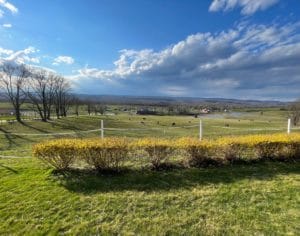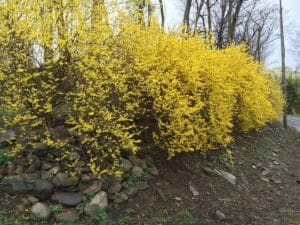Hello fellow readers, I’m a fan of allowing plants and people to grow to what they are meant to be. Not mold them into something they are not or prune them into unnatural shapes. Although formal gardens often call for pruned hedges or topiaries and such. And so, there are exceptions. One that took me by surprise is a row of forsythia at the Home for Hospice.
A forsythia hedge frames farmland at the Home for Hospice.
Framing the lawn overlooking the expansive farmland views beyond the Karen Ann Quinlan Home for Hospice in Fredon, NJ, is a hedgerow of what I thought was boxwood. But it turns out the clipped hedge is now bursting in yellow, offering a sunny foreground to the field dotted with horses in the view from the rooms. (I’m delighted to share that I’m back to visiting and providing music at the Home for Hospice, with my buddy Ken Roberts, after a hiatus due to covid protocols.)
Forsythia is one of the first shrubs to bloom, announcing Spring has arrived! It’s the first time I’ve admired a clipped hedge of forsythia as I prefer their natural weeping fountain form. I love the sunny welcome to the bland dormant landscape. But they can indeed turn into unwieldy shrubs after the early yellow wake-up call, inspiring folks to prune them into unnatural shapes. Especially if it grows above six feet, folks tend to prune the lower parts creating a shrub with a funky haircut- clipped on the sides and floppy on the top.
Forsythia Flowering Tips
Forsythia spreads readily, so I never recommend using them close to the house. They are beautiful and practical as screening from neighbors on larger properties. I imagine the grounds crew at the Karen Ann Quinlan Home for Hospice, with plenty of space to grow, opt to prune the shrubs as a hedge to preserve the magnificent views for families and patients.
Forsythia bloom on year-old wood, meaning this year’s new growth will bring next year’s flowers. So unless you prune it right after the flowers fade, you’ll miss the golden glory the following year. The same is true if deer nibbled. Despite its high rating of deer resistance, deer will eat the newer growth if they are hungry during snowy winters.
Forsythia needs about six hours of sunlight to bloom. And too much nitrogen can hinder bud production. So, if you are spreading lawn fertilizers high in nitrogen (please don’t), adding phosphorus such as bone meal should help counteract the nitrogen overload. However, the lack of blooms is most often due to improper pruning.
Golden glory meets ecologically friendly.
A side note here: My dear Curt’s brother cut Easter brunch short to run home to mow his lawn and spread pre-emergent to prevent annual weeds such as crabgrass. I wonder if he used a popular five-step turf builder program sold at box stores.
The Early Spring application’s active ingredient is Pendimethalin, which is highly toxic to freshwater fish, including rainbow trout, and slightly toxic to birds such as mallard ducks, according to Science Direct reporting from the Encyclopedia of Toxicology, 2014. They write that Pendimethalin is nontoxic to honeybees, which is good. But rather than chemicals, why not spread organic corn gluten—an environmentally friendly pre-emergent for annual weed control. The time to apply corn gluten is when forsythia is in bloom. Golden glory meets ecologically friendly.
Even old dogs (not so old, thank you very much) can learn new tricks. I’ve learned to adore hedges of golden forsythia, and hopefully, more will choose ways to inhibit undesirables without putting wildlife at risk. Garden Dilemmas? AskMaryStone@gmail.com.com (and your favorite Podcast App.)
There’s more to this story in Episode 53 of the Garden Dilemmas Podcast
Link to a related column Forsythia not Blooming?






Thanks for this piece about forsythia. I have a magnificent forsythia “hedge” at the edge of my yard, just before the very steep slope to oblivion behind it. It has grown and spread, unfettered, for a number of years, and I’ve cut and rooted branches in other inaccessible parts of my yard. With the cooler weather this Spring, the flowers have lasted a long time. The forsythia hedge delights me all year-round, as many birds seek cover there. For many reasons, I do not feed the birds, although I do provide water in a variety of containers around the yard. Of particular joy is the cardinal pair that spend t ime among the branches. I continue to enjoy your weekly column!
Thank you, Mary! I love hearing stories about plants that provide homes for critters. And providing water for birds is the kindest thing to do. Thank you for sharing. And for your kind words about my column. It means so much, Mary
I really like your column on forsythia hedges. Planning on planting a hedge/bush or two for critters for winter and to keep some rampant buckthorn at bay
Thank you, Amy, Kind of you to say. Thank you for reading my column :^), Mary